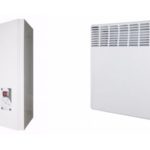Electric space heating devices are very popular and are a worthy alternative to gas or district heating. Among the most common for stationary heating are actually electric convectors and electric boilers. Let's take a closer look at the properties of each of them and compare what is better than an electric boiler or convectors.
What is an electric convector
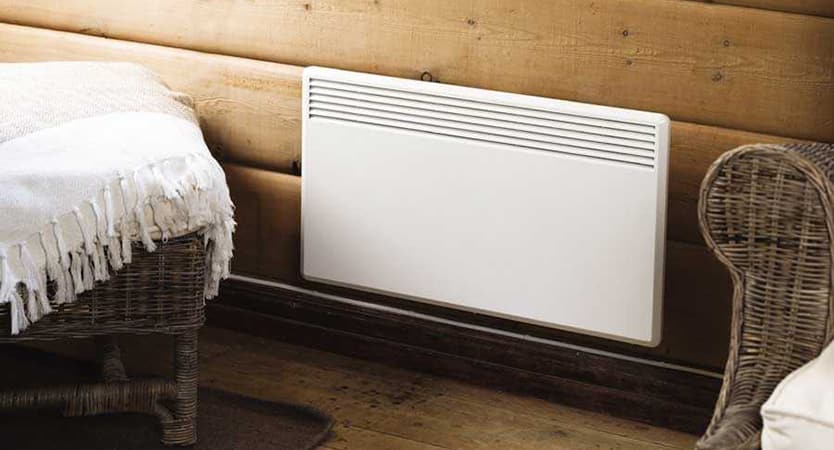
An electric convector is a modern type of heating technology. It is a rectangular metal case. The body has special holes through which cold and heated air passes. In the middle, the convector has a heating element. Cold air enters, heats up there and then goes outside. During the operation of the device, there is a natural circulation of air masses. It takes up to two hours to fully heat the room. At the same time, not only air is heated, but also furniture and floor are gaining heat, which retain heat.
Subsequently, the temperature is automatically maintained. The automatic temperature maintenance function can be of two types: mechanics, electronics. Effective one with an electronic sensor. This makes it possible to set the exact temperature and maintain it. In addition, a device with an electronic temperature sensor is considered more economical and can save up to ten percent of energy consumption along with a mechanical type of temperature control.
![]() See also - Which electric convector is best to buy for a home in 2025 year
See also - Which electric convector is best to buy for a home in 2025 year
Pros and cons of convectors
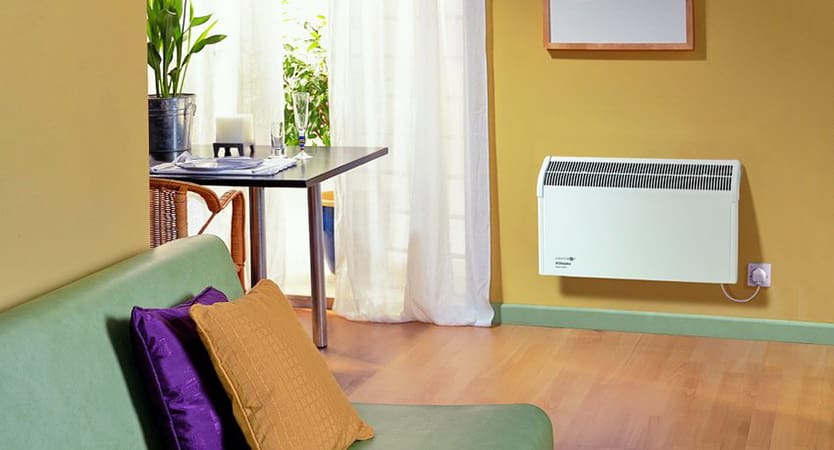
In order to somehow get an idea of the electric convector, we list its main advantages and disadvantages. The ratio of pros and cons will allow you to objectively evaluate the device.
And so, the indisputable advantages of this heating device:
- Savings on installation. Sometimes its placement does not even require installation (floor-standing), or requires minimal costs (wall-mounted). Almost only built-in convectors will require a little more installation effort.
- We use it if necessary and pay only for the used heat.
- Compact and small-sized.
- Available in operation.
- Such a device can be used in a room for various purposes (bathroom, garage or other room).
- Equipped with additional features. In particular: a humidifier, a fan for fast air circulation.
- Safe.The case does not heat up to high temperatures, eliminating the risk of burns.
Among the disadvantages for these heaters are:
- Uneconomic in terms of electricity use.
- They can dry the air, which is accompanied by a specific odor.
TOP-3 best convectors
- Noirot Spot E-3 Plus 1500
- Electrolux ECH / AS-1000 MR
- Ballu BEC / ETMR-2000
![]() See also - Comparison of an electric convector and a fan heater
See also - Comparison of an electric convector and a fan heater
Installation of convectors
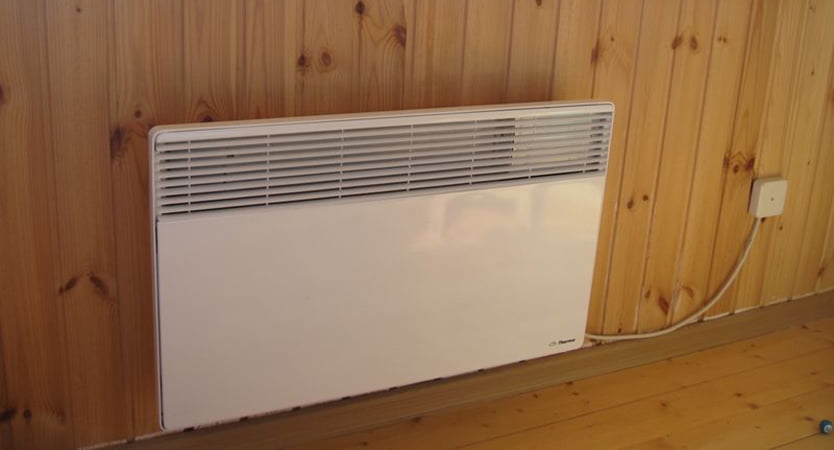
The advantage of these convectors is their ease of installation. In fact, they do not require any connection to communications, etc., in addition to being connected to the mains.
Depending on the type of convector itself, the installation method is different. Let's consider their main types:
- The universal type, the most common type of electric convector. It can be installed in different ways, which is its indisputable advantage. Such convectors are equipped with: legs (stands) that allows it to be placed directly on the floor and moved, if necessary, to any other place; brackets with which the heater is mounted on the wall. Moderate heating of the case allows it to be installed on a variety of surfaces, and there is no threat of melting or fire.
- Wall type, the same universal with the exception of the lack of stands for floor placement. As noted above, there are practically no specific contraindications for its installation. But it should be taken into account that the heated air will go from bottom to top. Therefore, directly in the area above the convector, it is not necessary to place objects that will experience harm from this. For example, fresh flowers and flowerpots or a cage with a parrot. Excessive clutter (overlapping) of the zone above the convector can also serve to block the flow of warm air.
- Built-in type of convector - it is supposed to be built into the floor or window sill. Usually used in non-residential areas. It is very effective where there are large glass partitions with the external environment or at the doors of supermarkets. In this case, the convectors create a thermal curtain, which prevents the warm air from leaving the room, the same as it does not allow the cold stream to enter.
![]() See also - The best manufacturers of gas boilers according to customer reviews
See also - The best manufacturers of gas boilers according to customer reviews
Heating the house with a convector
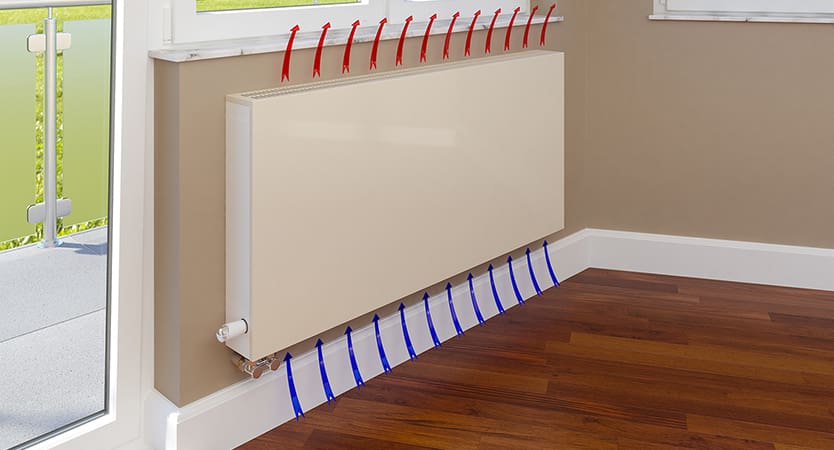
The convector for heating living space is gaining more and more popularity. Usually, they should be used in an area ratio for efficient and sufficient heating.
Most devices allow you to adjust the power. Actually, the ability to heat a certain area will depend on the power. Usually one convector is enough for one room. It is worth considering the internal microclimate. For rooms with a high level of moisture, where there is a risk of mold, you should choose more powerful convectors and in the amount necessary for a given area. This is important to restore the necessary healthy living atmosphere.
Their installation does not require additional connection to communications, only to the outlet. That is its advantage and disadvantage. They work from the mains and when disconnected, it is ineffective. Of course, electricity bills will grow substantially.
Ease of installation, offset by increased electricity bills.
Such convectors are not only simple and efficient, they also have a modern design. Usually the standard models are of the same type. But, among the assortment, you can find heaters with different bodies, which allows you to choose the style of your room. It can be disguised so that the device becomes a decorative element. And also cladding is practiced under your personal order, for example, with a stone.
It should be noted that this is a moderate option for the price. Of course, it depends on the manufacturer, power, design and the like. However, average prices are fully accessible to the average statistical class of the population.
Features of electric boilers
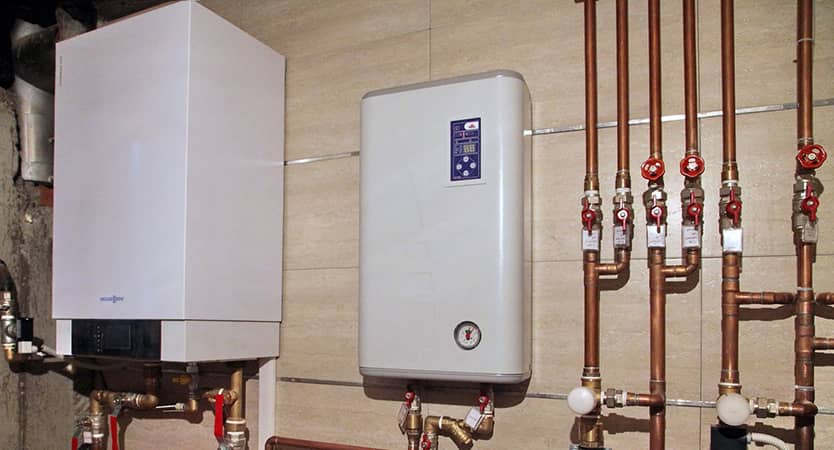
An electric boiler is a heating device that is capable of heating a large area, thanks to the provision of heat supply from a central heating device to the actual heat sources. That is, inside the boiler itself there is a heating device. It heats the water, and the water passes through the laid pipelines to the radiators (batteries), which are the sources of heating.
The peculiarities of electric boilers are that they:
- Do not dry the air. Do not burn oxygen, and do not create the sensation of combustion in the air.
- You can pick up double-circuit models that can not only heat the room, but also provide hot water supply.
- Unlike single heaters, an electric boiler can effectively heat a fairly large area. After all, it is the center, the distributor of heat supply.
The price will also depend on the complexity of the installation itself. It can be noted that low-power, simple installations are quite cheap.
Depending on the needs and the room where it will be used, you can choose a simple or more advanced version, in particular, boilers are distinguished:
- Equipped with a heating element and a trigger for commissioning.
- In addition to standard settings, they are equipped with temperature control sensors.
- Advanced options include a remote control system.
TOP 3 best electric boilers
- Buderus Logamax U072-24K
- Protherm Slope 6 KR 13
- EVAN EXPERT 9
Electric boiler heating elements
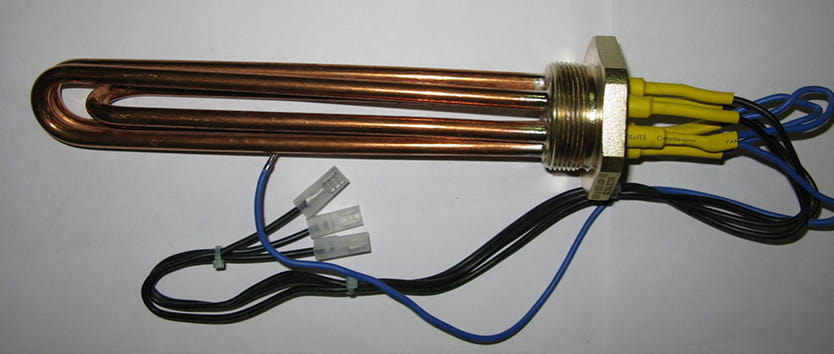
All electric boilers can be divided depending on the type of heating element. Each of them has its own operating principle and features. And so, such boilers can contain:
- TENI - a well-known and common way of heating water. The tubular heating element heats up the water, which moves and provides uninterrupted heat supply.
However, it has certain disadvantages. TENA often suffers from limescale resulting from heating water and high temperatures. Because of this, it fails. This is solved by replacing the heating element. But it can still create discomfort in the heating season.
- Electrode heating is an efficient and reliable heating method. The electrodes are placed in the coolant itself. That is, the water is heated in a collision directly with the heating chamber. Heats up very quickly and reliable in terms of fire safety. In particular, in the absence of a heat carrier, the boiler switches itself off.
- Induction - modern, most reliable and efficient types of heating system. According to the principle of operation, they exclude direct collisions between current and water, exclude scale. Therefore, they are considered durable and safe, however, at a price the most expensive type of heating (of the number of electric boilers).
Installation of electric boilers
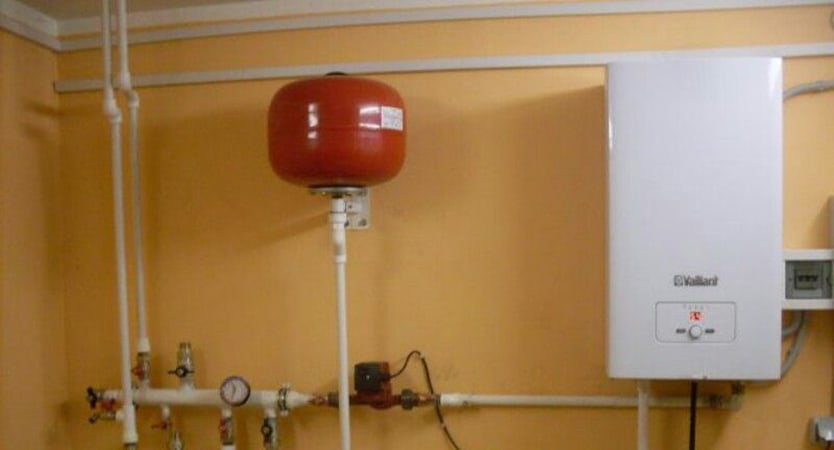
If compared with an electric convector, then installing an electric boiler is several times more difficult, and requires:
- Choice of installation location: possibility of connection to the pipeline and access to the socket.
- Installation of the installation itself. Usually, detailed instructions go to him, which will allow the clever owner to carry out the installation himself without the help of specialists. However, it is necessary to study the installation process in detail, in particular, to stock auxiliary parts for installing the boiler. For example, a faucet for water does not always come with a boiler.
It should be noted that, unlike convectors, boilers have a less aesthetic appearance. Therefore, it is better to plan the installation in advance and choose a place that is least viewed. In order to conveniently place the boiler, it should be remembered that its installation is possible in two ways: wall mounting, floor installation.
Considering the advantages of this heating system, it can be noted that the previous planning steps for its installation are fully justified by its efficiency. After all, this installation will provide heat around the entire perimeter of the apartment and in cold weather, effectively provide the warmth and comfort of your home.
The advantages of an electric boiler:
- From the moment of switching on, heating starts quickly. Radiators (batteries) to which hot water is supplied quickly spread heat over the area.
- Safe, unlike gas heating, which is explosive.
- If necessary, it can be easily reconstructed for a gas boiler. Since the main system is piping and batteries, they are the same for both types of heating.
Among the disadvantages:
- Painstaking process of installing the system. Carrying out pipes, installing batteries, require qualified and high-quality installation.
- Combining an electric heater and water supply in one system is not completely safe.
- Requires a stable and well-functioning power supply system, due to its constant and significant load.
- High energy costs.
What is more economical than an electric boiler or convector
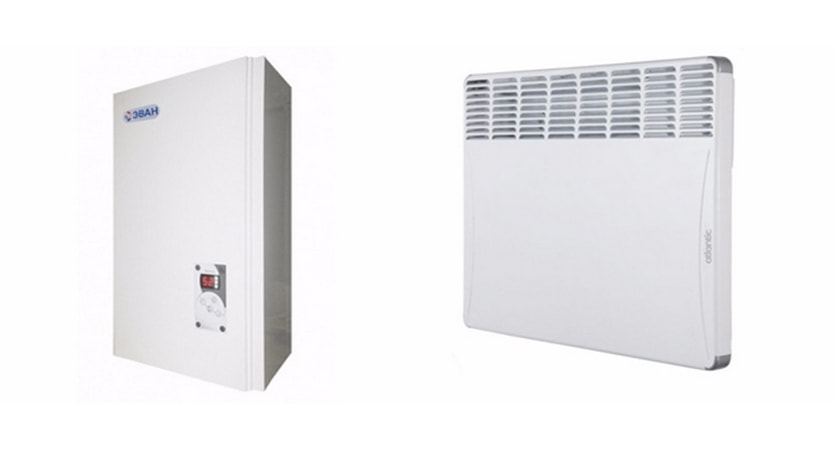
A comparison of the electric boiler and convector makes the picture clear about the appropriateness of using this or that type of heating.
If we compare the cost of electricity, then both types of heating have an increased type of consumption. Both devices have approximately the same costs of approximately 240 kWh per day for heating an area of 100 m².
Usually, in practice, other factors, such as heat loss, power of the electrical appliance, etc., are also important for the accurate calculation of electricity costs.
In addition, you can improve the energy saving process for both devices. For example, a more profitable boiler with the function of setting the set temperature, which will save costs.
In principle, the convector can be disconnected from the mains when and where heating is not needed.
If we talk about an electric boiler, then this type of heating is most appropriate for large areas. After all, the installation of such a system for a small area does not justify the installation costs, especially when alternative heating methods are available. In addition, heating a small area is much easier than large spaces, and an electric convector is often enough for this.
Convectors are very relevant where there is no central pipeline and there is no expediency of repair and installation work on its installation. Including, if it is not a long-term housing. Convectors can easily be dismantled with subsequent use in another room.
Therefore, the choice should be made based on the area, the need for stable or periodic heating and other features of the room and your requirements for the heating system.
See also:
- Choosing a solid fuel boiler for long burning: rating of the 10 best boilers
- 11 best home water heaters according to user reviews
- 13 best gas heating boilers according to buyers' opinion
- 17 best electric boilers according to buyers' opinion
- 19 best indirect heating boilers according to customer reviews


